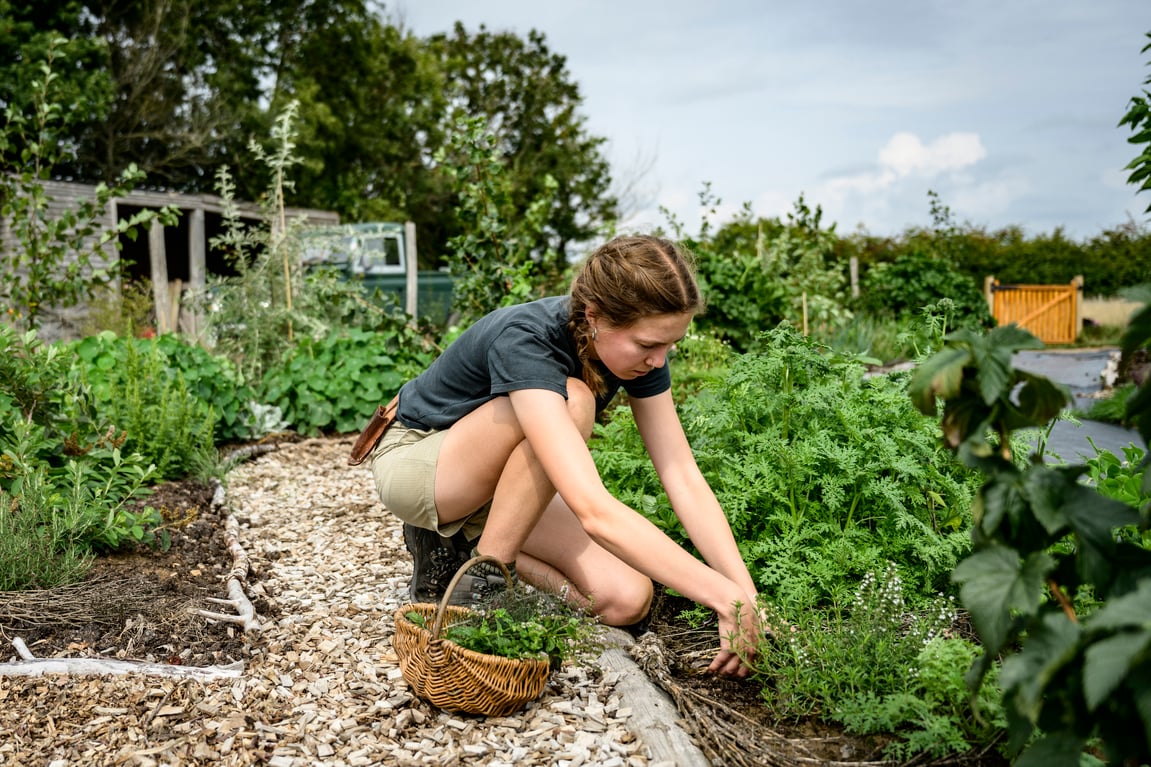5 Medicinal Herbs You Can Plant Once and Harvest for Years to Come

Wondering how to grow medicinal herbs for your homestead without a lot of experience? An herb farmer shares how to grow five perennial medicinals that will come back year after year.
Learning to grow your own medicinal herbs is a powerful skill that can lead to greater health and self-sufficiency.
I know because my husband and I run a medicinal herb farm in Western North Carolina.
But before we bought our mini farm and started growing herbs for profit, we grew our own medicinals in our small suburban neighborhood backyard (while working full-time jobs).
You can do the same for very little effort and investment, especially if you plant perennial medicinals, which will come back after several cuttings for years to come.
The following are 5 medicinal herbs you can plant once and harvest for years to come, no matter how large or small your garden is.
Top 5 Perennial Medicinal Herbs Best Suited for Southern Climates
Herbs are notoriously easy to grow and very forgiving.
However, some varieties really thrive in our steamy Southern summers and temperate winters.
These five perennial herbs all serve a different purpose and grow beautifully in the Southeastern United States climates.
I’ll also share their health benefits based on research and herbal folklore.
1: Lemon Balm

Lemon balm is my absolute favorite herb because:
- It tastes amazing in tea. I like blending it with Jasmine Green tea for my morning brew and Red Clover and/or Thyme for a healthy herbal nightcap.
- It is rich in antioxidants and has immune-supportive properties.
- It’s a nervine, which means it supports the nervous system and helps reduce stress.
- It’s a nootropic, a classification of herbs that promotes cognitive function.
- It’s super easy to grow.
- You can cut it multiple times in a season.
- It looks great, smells great and attracts pollinators.
Lemon balm has been traditionally used as an antimicrobial, antiviral, antispasmodic, antiparasitic, antistress and for insomnia and cognitive support.
Modern research has also discovered it may help with herpes simplex 1 through polyphenolic plant compounds, mainly rosmarinic acid, and is high in antioxidants.
So, if you’re looking for tasty immune support that also helps you relax and supports brain function, Lemon Balm is your herb.
Growing Lemon Balm is so easy; anyone can do it.
Although you can buy starts, Lemon Balm is so forgiving I recommend growing from seed to save money and yield more plants (once you taste it, you’ll want lots of it!).
You can directly sow it in healthy or even marginally healthy soil, and it will pop up in just a few weeks.
From there, just sit back and watch it attract beneficial bugs as it grows.
It’s time to harvest when it begins to flower, which is when it’s most flavorful. You can harvest it before flowering, but it won’t have such an intense grassy lemon flavor.
When harvesting, leave one-third of the plant, and it will regenerate quickly.
We typically get 3-4 harvests from our Lemon Balm plants per season.
To preserve, dry it in a dehydrator or air-dry, roll the dried herb between two clean kitchen towels to garble (remove the herb from the stem and break up), and store it in a clean and dry container.
2: Lavender
Lavender is typically associated with hot and dry Mediterranean climates. However, as discussed in: The Woodstock Lavender Company—A Mother-Daughter Herb Farm Thrives in Rural Kentucky, certain varieties grow very well down South.
We planted our first lavender plant about four years ago, and it has now blossomed into an enormous bush that gets bigger and more beautiful every year. Last year we put in a hedge row of about 30 plants that we started from seed, and look forward to the bounty that is to come.
This beauty attracts a ton of bees, smells amazing, and gives us loads of lavender sprigs to harvest at the end of the season for bouquets, cooking, and teas.

We’ve enjoyed this so much that we’re starting a row of lavender for our herb farm this year and plan on expanding that in years to come (growing lavender can also be very profitable).
Growing lavender is a cinch. You can either purchase plants (like we did with this one), plant them, mulch them heavily, fertilize them with compost occasionally, and forget them, or start your own seeds.
According to Allison Horseman and her mother Mary May, the founders of Woodstock Lavender Company in Kentucky, the best lavender plants for Southern climates are: “Phenomenal” and the highly fragrant English varieties
The health benefits of lavender are impressive.
Studies show that lavender flowers, leaves and essential oils can support immunity and emotional well-being, reduce stress, promote healthy skin, help with fungal infections, reduce pain, support digestion and soothe tummy trouble, protect the brain, help ease PMS, support hair growth, promote wound healing, and improve sleep.
It’s also a natural insect and tick repellent (especially when combined with geranium) and an excellent companion plant to ward off garden pests when planted with rosemary.
On a personal note, our massive lavender bush is dedicated to my mother, Gwendolyen Clarke, who died in June 2020.
She loved flowers and grew the most beautiful flower gardens in her homes in British Columbia, Canada. So, we sprinkled some of her ashes on this plant, which is partly why I believe it has flourished.
3: Oregano
Most people think of oregano as a culinary herb.
However, several studies have shown it is a powerful immune-supportive herb with antiviral, antibacterial and antifungal properties.
Hence, oregano oil supplements have become so popular.
It’s also wonderful for hair and skin and is a natural bug repellent.
Our oregano plant was planted about four years ago and it’s come back stronger and bigger every year (despite being fairly neglected and planted next to a large and very wild berry patch).
Ideally, you want healthy soil with full to partial sun exposure.
In other words, oregano is hearty and requires very little attention.
Unless you plan on using copious amounts of it or making your own oregano oil, one plant is likely enough for a family of four, but planting more is easy and doesn’t require a lot of space.
You can buy an oregano plant and plant it in healthy soil with good compost, direct seed (yielding several plants), or start your own oregano plants, plant what you want, then give the rest to friends or family.
Once established, you can harvest it for years to come.
We like drying ours, which gives us a stash of ultra-fresh and fragrant oregano to last all winter long.
The simplest ways to reap its benefits are to use it in a tea or cook with it.
To make immune-loving oregano tea:
- Steep 1 teaspoon dried oregano or 5 sprigs fresh in boiling water for 5 minutes.
- Sweeten with honey or your favorite sweetener and a bit of lemon.
- Enjoy!
4: Cone Flower Echinacea Purpurea

Cone flowers, also known as Echinacea, are beautiful and functional medicinal flowers.
Starting these from seed can be a little finicky and require a couple of years to flower, so I like buying established plants from our local nursery.
They return every year, will self-seed in many cases, resulting in more plants year after year, are available in various colors, and are amazing for immune support.
Echinacea is a hearty plant that likes healthy soil with full sun and tolerates drought.
The entire Echinacea plant can be used as medicine. However, to preserve it as a perennial stick with harvesting the flowers and leaves.
Flowers can be cut at any time during the blooming season and turned into a tea or tincture, and more flowers will return.
To harvest the leaves, cut the plant just above the first set of leaves to preserve it for future seasons.
To make tea from fresh flowers, steep several flowers in boiling water for 20 minutes, strain, sweeten, and enjoy.
You can also dry the leaves and flowers to make teas in the non-growing season for immune support.
Echinacea tea has a strong floral flavor with a bit of zing. Many people like combining it with Lemon Balm and/or Mint to help tone down its floral flavor.
See: How to Make Echinacea Tincture — DIY Recipe from Practical Self Reliance for step-by-step instructions on making your own Echinacea tincture just using Echinacea and mid-grade vodka.
5: Chrysanthemum
Yep, you read right. Specific varieties of Chrysanthemums are considered medicinal plants in Traditional Chinese Medicine.
They’re also wonderful perennials to plant once and enjoy their beauty at the end of summer/early fall, before harvesting the flowers to use in teas.
Traditional Chinese Medicine practitioners love Chrysanthemum (pin yin name is Jua Hua) to support the lungs, liver, eyes, ears, nose, kidneys, heart, and throat. It also has sedative properties and is traditionally used for fever, cold, and flu.

Research has shown Chrysanthemum tea is a rich source of anthocyanins, a type of antioxidant that protects cell health while helping reduce inflammation.
When growing chrysanthemums, it’s important to source high-quality plants or seeds, as your typical potted mum found at a big box store will not come back year after year.
To grow Chrysanthemums you have four options:
- Start from seed.
- Buy plants and transplant (easiest!).
- Propagate cuttings.
- Or propagate by division (splitting them at the start of the season, like hostas).
Starting from seed is generally not recommended as it tends to be challenging to maintain attributes from the parent plant. This means you may not get the flower of the color or size you want.
The easiest way to grow chrysanthemums is to buy the plants and transplant them in your garden. Strictly Medicinals has medicinal chrysanthemum plants in various sizes that are ready to plant.
Simply plant these in full sun in healthy soil, water and watch them grow into large, beautiful flowering plants.
Once you have these established, you can propagate more plants from cuttings. Here’s how.
To propagate cuttings:
- Clip about a 4-inch sprig from the top growth of an established plant just above a set of leaves.
- Gently strip the bottom leaves off leaving and put the area where you cut the leaves off (where the nodes are) and bury in soil.
- Keep the soil very moist, and it is helpful to put on a propagation dome to maintain high humidity.
In a few weeks, the cuttings should have rooted and will be ready for transplanting after your first frost date.
Lastly, and the easiest, is to grow by division.
This is as simple as dividing the first shoots you see come up in the spring by pulling them out of the ground, separating them from the parent plant, and planting either immediately into the ground or into pots with high-quality potting soil.
It is best to do this with some established plantings, but it is another great option and, in my opinion, the easiest.
How to dry chrysanthemums:
- Dried blossoms are always best for making chrysanthemum tea.
- With a home-scale dehydrator, you can dry the flowers in 3 to 4 days.
- Dry on the lowest heat setting possible (around 90 degrees F) and make sure the blossoms almost crackle when you handle them.
How to make chrysanthemum tea:
Note: make sure you’re making tea from the medicinal variety and not a mum you bought at a big box store, which may contain pesticide/herbicide residue and not have the same effects.
- Use 2 to 3 blossoms per cup.
- Put them into a tea brew pot or stainless steel strainer, pour just boiled water over the top, and cover the brew (covering helps retain heat and better draw out flavor and medicinal compounds).
- Let steep for 10 minutes, and it's ready to drink.
Sweeten with honey if desired.
Let’s Recap How to Grow Medicinal Perennials
Whether you start with one of these medicinals or try all five, they will reward you by producing beautiful plants and medicine every year for years to come.
So don’t think you need perfect soil or even a green thumb to grow your own medicinal perennials.
Lemon Balm is an excellent first herb because it’s incredibly forgiving and has many beneficial properties. Oregano too, is very easy to grow and doubles as a culinary and medicinal herb.
For more information on herb growing, check out the following articles:











Your email address will not be published. Required fields are marked*